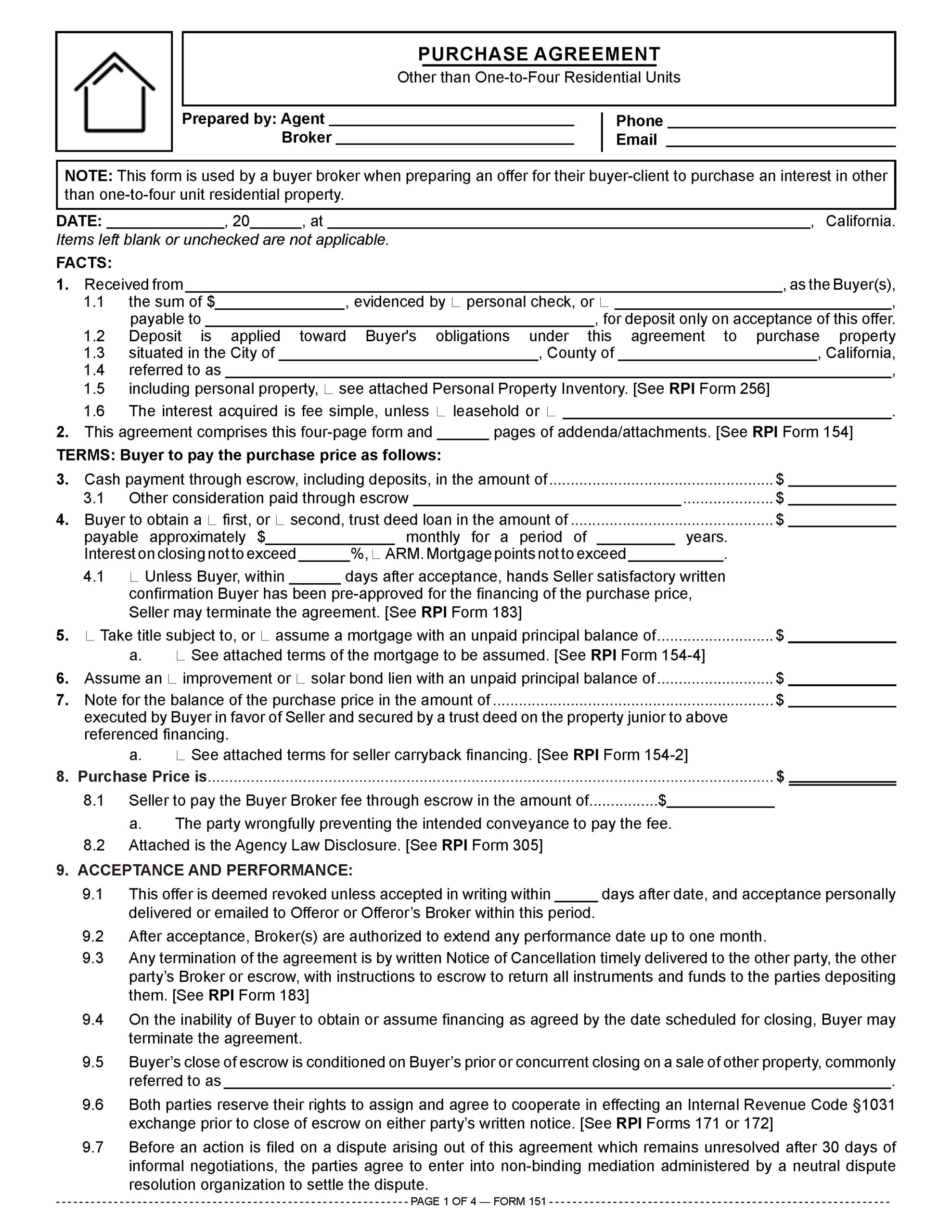This form is used by a buyer broker when preparing an offer for their buyer-client to purchase an interest in other than one-to-four unit residential property.
Purchase agreement practice
A purchase agreement form is the primary document a buyer broker uses to prepare a buyer’s offer to submit and negotiate a real estate sales transaction between a buyer and seller.
Different types of properties, financing and the type of interest acquired in a property require a diverse variety of purchase agreements, options, lease agreements and exchange agreements. Here, we review a purchase agreement for a property other than a one-to-four unit residential property. The property may be a multi-family building or a commercial space. It’s income-producing real estate. [See RPI Form 151]
In contrast, when the property to be acquired is a single family residential (SFR) parcel with four-or-less residential units, the purchase agreement used is tailored to accommodate one-to-four residential unit sales. [See RPI Form 150]
Preparing a purchase agreement in 2025 and beyond
Before preparing a purchase agreement offer for review with their buyer-client, the buyer broker by necessity negotiates their fee and enters into a buyer representation agreement. The employment, otherwise known as a BRA, authorizes the broker to represent their buyer-client. The BRAs are distinguished by whether the buyer-client is an individual or an entity. [See RPI Form 103.1 and 103.2]
Purchase agreements, on the other hand, make no distinction about what type of person is buying a property, unconcerned as to whether the participants are individuals or entities. However, purchase agreements make a distinction about whether the property contains four-or-less residential units or is a different type of property.
Negotiations for entering into a buyer representation agreement take place before the buyer agent begins any effort to meet the buyer’s objective to buy property — any type of property and any type of interest in that property. Efforts of a buyer broker include any aspect of locating residential or commercial property, analysis of the buyer’s price point capacity, advice concerning a property for acquisition, and any activities which lead to acquiring an interest in a property.
Before any work on behalf of the buyer is undertaken, the agent needs to first clear with their broker or office manager the propriety of the broker’s office representing the buyer-client. Conflicts of interest or dual agency scenarios do often present themselves. When they exist, the broker and their agent need to resolve these conflicts and make disclosures before moving on in their efforts to achieve the client’s objectives.
Further, the demeanor of the buyer might cause a prudent broker to avoid having their agents spend time assisting the buyer. Simple prior planning needs to take place when any fiduciary (read: buyer broker) considers representing a buyer-client.
On confirming the representation of the buyer is proper, the agent prepares a buyer representation agreement. The buyer broker sets the fee deemed to be necessary which is entered as an integral provision in the representation agreement. Each broker properly establishes the fee amount they charge for their services. Brokers set their fee based on the value of their time and the probability of earning it, not in collaboration with another broker or trade union as the cooperating broker price-fixing dog whistle.
The agent then reviews the prepared buyer representation agreement with the prospective buyer-client for their approval and signature. The buyer negotiates the fee with the broker. Only after receiving a signed representation agreement is the buyer broker and their agent legally authorized to proceed to diligently locate, advise and assist the buyer to purchase property, and collect a fee they earn.
Without first negotiating a signed representation agreement with the buyer-client, a broker is prohibited from preparing and reviewing a purchase agreement offer for their buyer-client to sign. [Calif. Civil Code §1670.50(a)]
The purchase agreement fee provision calls for entry of the buyer broker fee amount as previously set in the representation agreement. [See RPI Form 151 §8.1]
While the purchase agreement sets out the buyer broker fee, it will never set out the seller broker fee amount — that practice is gone with yesterday’s antitrust violations. Each broker sets their own fees, separate from what other brokers charge their clients.
Conversely, the fee due the buyer broker is not of concern to the seller or the seller broker. However, the seller broker protects their fee by negotiating and entering into a separate representation agreement (formerly called a listing) signed by their seller-client. [See RPI Form 102]
Of course, as before, the purchase price the buyer funds is always the source for payment of all broker fees. No closing, no fee. The seller broker, when disclosing material facts to their seller-client, prepares and reviews a net sheet with their client. The payment of all broker fees on the transaction are charged to the seller and disbursed by escrow on receipt of the buyer’s purchase funds. No change there. [See RPI Form 310 §4.31]
Analyzing the purchase agreement for other than one-to-four residential units
A buyer broker uses the Purchase Agreement — For Other than One-to-Four Residential Units published by RPI (Realty Publications, Inc.) to prepare and submit the buyer’s written offer to purchase income-producing property, excluding one-to-four unit residential property. [See RPI Form 151]
Terms for payment of the price are limited to conventional financing, an assumption of existing mortgages and a carryback note. Sellers also properly use the purchase agreement in a counteroffer situation to submit a fresh set of terms as an offer to sell the real estate. [See RPI Form 151]
The purchase agreement offer, when accepted, becomes the binding contract between the buyer and seller. Its terms need to be clear and complete to prevent misunderstandings so any agreement entered into may be judicially enforced. Thus, Form 151 is a comprehensive “boilerplate” purchase agreement. Importantly, it serves as a checklist, presenting the various conventional financing arrangements and conditions — contingencies — a prudent buyer considers when drafting terms of an offer to purchase. [See RPI Form 151]
Each section in the Purchase Agreement — For Other than One-to-Four Residential Units has a separate purpose and need for enforcement. The sections include:
- Identification: The date of preparation used to reference the agreement, the name of the buyer, the amount of the good-faith deposit, the description of the real estate, an inventory of any personal property included in the transfer and the number of pages contained in the agreement with its addenda. [See RPI Form 151 §§1 and 2]
- Terms: The details of how the buyer funds the purchase price, including the down payment, mortgage amount, interest rate and any improvement or solar bond liens. [See RPI Form 151 §§3 through 7]
- Purchase price and broker fees: The amount of the purchase price offered to acquire the property and the buyer broker fee amount. Also, the Agency Law Disclosure form is attached. [See RPI Form 305; See RPI Form 151 §8]
- Acceptance and performance: Aspects of the formation of a contract and excuses for nonperformance and termination of the agreement, such as the time period for acceptance of the offer, the broker’s authorization to extend performance deadlines, procedures for cancellation of the agreement, the financing of the price as a closing contingency, a sale of other property as a closing contingency, cooperation to effect a §1031 transaction, and limitations on monetary liability for breach of the agreement. [See RPI Form 151 §9]
- Property conditions: A checklist of reports the seller is to provide the buyer prior to closing and seller performance provisions are listed. [See RPI Form 151 §10]
- Due diligence contingencies: Contingencies for the buyer’s due diligence investigations into income and expense records, rental income statements, hazard disclosures, property condition disclosures and other relevant information to be delivered by the seller are listed in an addendum for consideration and checking those applicable to the agreement. [See RPI Form 279; See RPI Form 151 §11]
- Closing conditions: The escrow holder, escrow instruction arrangements and the anticipated date of closing are established, as are title conditions, title insurance, hazard insurance, prorates and mortgage adjustments. [See RPI Form 151 §12]
- Notices: Regarding sales data and supplemental property tax bill. Authorizes the broker to report the sale of the property, its price and terms for dissemination in brokerage trade associations or listing services. A required notice about property tax bills to be paid by the buyer. See RPI Form 151 §13]
- Blank: Miscellaneous provisions not included elsewhere in the body of the form are listed here. [See RPI Form 151 §14]
- Signatures: The seller and buyer bind each other to perform as agreed in the purchase agreement by signing and dating their signatures to establish the date of offer and acceptance. [See RPI Form 151]
Form navigation page published 02-2025.
Form updated 02-2025.
Form-of-the-Week: Purchase Agreement — For Other than One-to-Four Residential Units — Form 151
Brokerage Reminder: RPI’s Purchase Agreement – fair and unbiased for all to use
Book: Real Estate Practice, Chapter 52: Income property acquisitions
Video: California Real Estate Forms and the Freedom of Choice














